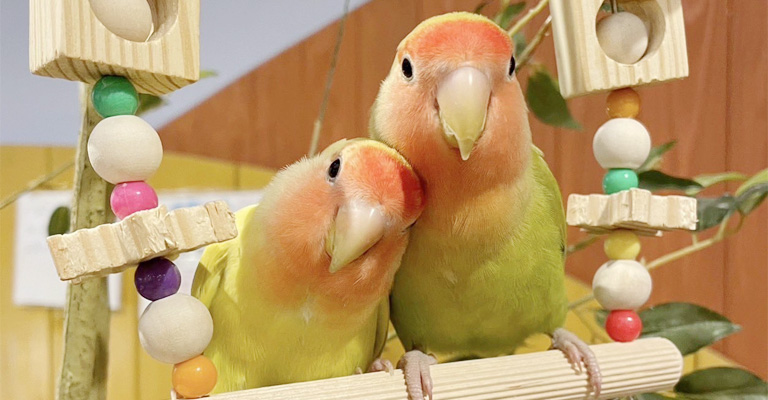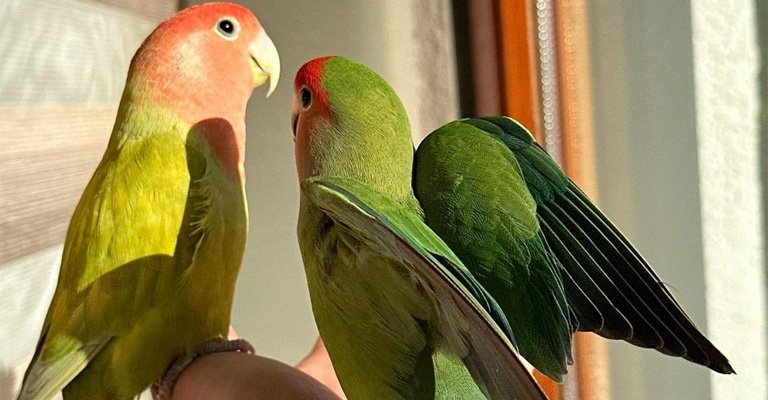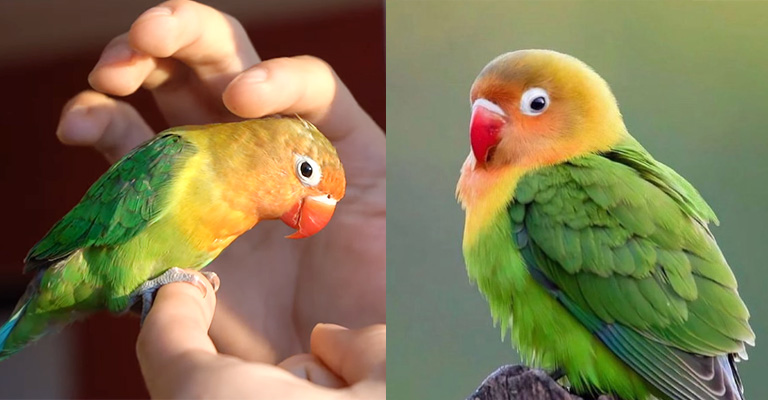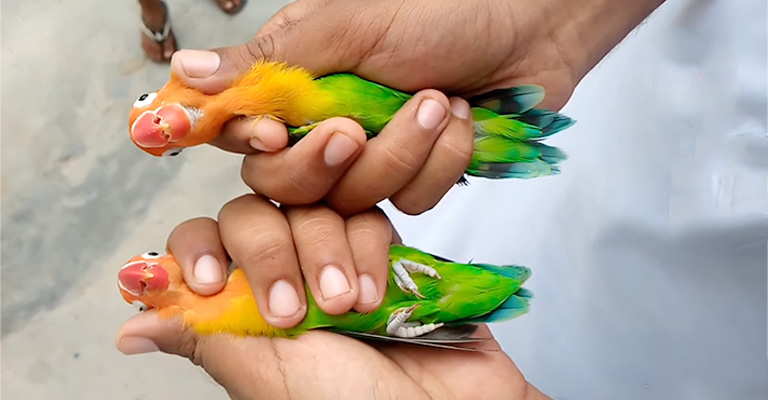Lovebirds are cherished for their vibrant personalities and affectionate nature. But when it comes to determining the gender of your lovebird, things can get a bit tricky.
Unlike some animals with distinct physical differences, lovebirds often keep their gender hidden behind their colorful plumage. Whether you’re curious about your lovebird’s gender or planning to pair them with a mate, understanding their sex is crucial.
In this comprehensive guide, we’ll explore various methods for identifying your lovebird’s gender, from behavioral cues to the most reliable DNA testing. We’ll debunk common misconceptions and offer insights into what to look for.
Knowing your lovebird’s gender can enhance your understanding of their unique characteristics and help provide better care.

Differences Between Male and Female Lovebirds
Lovebirds are small parrot species known for their strong pair bonding and affectionate behavior. While it can be challenging to distinguish male and female lovebirds solely based on their physical appearance, especially in some species, there are some general differences and cues that can help in identifying their gender:
Size
In some species of lovebirds, males are slightly larger than females. This difference in size may not be very noticeable unless you have both a male and a female for comparison.
Behavior
Lovebird behavior can vary between males and females, but it’s not a guaranteed way to determine their gender. Some general observations include:
Males may be more vocal and tend to make more noise, including louder chirping and singing.
Females may be quieter and more reserved in their behavior.
Coloration
In certain species of lovebirds, there may be subtle differences in coloration that can help identify their gender:
Fischer’s lovebirds, for example, typically have a more vibrant and brighter coloration in males compared to females. Males often have more vividly colored facial markings.
In Peach-faced lovebirds, males tend to have more extensive and brighter coloring on their faces.
Behavior During Courtship and Bonding
During courtship, males often engage in more active and demonstrative behaviors, including offering food, dancing, and regurgitating to feed the female.
Females may show more submissive behaviors during courtship, such as crouching or allowing the male to feed them.
Nesting Behavior
Female lovebirds are responsible for most of the nest-building activities. They often gather nesting materials and construct the nest. However, this behavior can be challenging to observe unless the lovebirds are in a breeding condition.
It’s important to note that these differences are generalizations and may not apply to all individual lovebirds, as there can be considerable variation within the species.
Additionally, the best way to determine the gender of a lovebird with certainty is through DNA testing or surgical sexing performed by a veterinarian. These methods provide accurate results without relying on behavioral or physical cues.
How to Know Whether Is My Lovebird Female Or Male

Determining the gender of a lovebird can be challenging without a doubt, as they don’t exhibit significant external physical differences between males and females in many species. To accurately determine the gender of your lovebird, you have a few options:
DNA Testing
This is the most reliable and accurate method to determine the gender of your lovebird. You can collect a small blood sample, feather follicle, or even a cheek swab, and send it to a veterinary laboratory that specializes in DNA sexing. They will analyze the sample and provide you with the bird’s gender.
Surgical Sexing
This method involves a veterinarian performing a minimally invasive surgical procedure to visually inspect the bird’s reproductive organs. This method is less common and typically reserved for specific situations, such as during health examinations or if DNA testing is not feasible.
Behavioral and Visual Cues (not very reliable)
- Observe their behavior during the breeding season. Males may become more vocal and display courtship behaviors like feeding the female or dancing.
- Look for subtle differences in coloration, but remember that these differences can vary widely between individuals and species.
- Measure the size of the lovebird, keeping in mind that in some species, males may be slightly larger.
Please keep in mind that relying solely on behavioral or visual cues can lead to inaccuracies, especially if your lovebird doesn’t display typical gender-specific behaviors or if you’re dealing with a species where gender differences are not obvious.
Therefore, if you want to be absolutely certain about your lovebird’s gender, it’s recommended to opt for DNA testing, which is a highly reliable method.
Behavioral Changes of Male and Female Lovebirds

Male and female lovebirds can exhibit different behaviors, especially during the breeding season and courtship.
However, it’s essential to remember that individual personalities and variations exist, and not all male and female lovebirds will behave exactly the same way.
Here are some common behavioral changes and tendencies seen in male and female lovebirds:
Male Lovebirds
- Increased Vocalization: Males often become more vocal during the breeding season. They may sing, chirp, or call more frequently to attract a mate.
- Courtship Displays: Male lovebirds may engage in elaborate courtship displays to woo females. This can include dancing, puffing up their feathers, and bobbing their heads.
- Feeding Behavior: Males may offer food to females as part of their courtship behavior. They may regurgitate partially digested food for the female, a gesture of affection and provisioning.
- Nest Building: In some species, males may participate in nest building, although it’s usually the female’s primary responsibility.
- Territorial Behavior: Males can become territorial during the breeding season, defending their chosen nesting site or mate from perceived threats.
Female Lovebirds
- Acceptance of Courtship: Females typically respond to the courtship displays and offerings of the males. They may show interest by crouching or allowing the male to feed them.
- Nesting and Nest Building: Female lovebirds are usually responsible for building the nest. They collect nesting materials and construct the nest cavity.
- Egg-Laying: After successful courtship and mating, females will lay eggs in the nest they’ve built. This is a clear sign that the female is preparing to become a parent.
- Incubation: Once the eggs are laid, females are primarily responsible for incubating them, keeping them warm, and turning them regularly.
- Protective Behavior: During the incubation period and when raising chicks, female lovebirds can become protective of their nest and offspring. They may become more territorial and defensive.
- Less Vocal: In some cases, female lovebirds may be quieter during the breeding season compared to males.
Remember that these behaviors can vary between different species of lovebirds, and individual birds may not always follow these patterns exactly. Additionally, lovebirds that are not in breeding condition may exhibit different behaviors.
Understanding the unique behaviors and preferences of your specific lovebird is essential for providing proper care and meeting their needs.
Differences in Vocalizationsof Male and Female Lovebirds

Distinguishing between the vocalizations of male and female lovebirds can be challenging because both genders are capable of making similar sounds.
However, some subtle differences in vocalization patterns may exist, although they are not consistent across all individuals or species. Here are some general observations regarding the vocalizations of male and female lovebirds:
Male Lovebirds
- Singing: Male lovebirds are often more inclined to sing or produce melodious sounds, especially when they are trying to attract a mate or during courtship. They may produce musical chirps or whistles.
- Loud Calling: Males may engage in loud calling or squawking, which can be part of their courtship behavior or a way to establish their presence in the territory.
- Attention-Seeking: Males might vocalize more when seeking attention from their owners or trying to interact with other birds.
Female Lovebirds
- Less Frequent Singing: While female lovebirds are capable of singing and vocalizing, they tend to do so less frequently compared to males, especially during the breeding season.
- Chatter and Chirping: Female lovebirds may engage in more chattering or softer chirping sounds. These sounds can vary in tone and intensity but are generally less melodic and loud compared to the songs of males.
- Quiet Incubation: When females are incubating eggs or caring for chicks, they often remain relatively quiet to avoid drawing attention to the nest.
It’s important to note that these differences in vocalization are not definitive, and individual lovebirds may not conform to these general patterns. Additionally, the vocalizations of lovebirds can vary based on their species, personality, and environment.
The best way to understand the vocalizations of your specific lovebird is through attentive observation and getting to know your bird’s unique vocal patterns and behaviors over time.
DNA Testing to Identify the Gender of Lovebirds
DNA testing is a highly accurate and reliable method for determining the gender of lovebirds and other birds. This method involves analyzing the bird’s DNA, specifically its sex chromosomes, to determine whether it is male or female. Here’s how DNA testing for lovebirds typically works:
- Sample Collection: A small biological sample is needed for DNA testing. The most common methods for collecting samples from lovebirds include:
- Blood sample: A small amount of blood is taken from a toenail or a vein.
- Feather sample: A few feathers, preferably plucked from the bird’s chest, are collected.
- Laboratory Testing: The collected sample is sent to a specialized avian DNA testing laboratory. In the lab, technicians will extract DNA from the sample.
- Analysis: The extracted DNA is analyzed to determine the presence of specific sex-linked genes or markers. In lovebirds, the presence or absence of these markers on the sex chromosomes determines the bird’s gender.
- Results: The laboratory will provide you with the results of the DNA test, indicating whether your lovebird is male or female.
Advantages of DNA Testing for Gender Identification in Lovebirds:
- Accuracy: DNA testing is extremely accurate and is considered the most reliable method for determining a bird’s gender. It can even identify the gender of very young or immature birds.
- Non-Invasive: DNA testing is relatively non-invasive and does not harm the bird. Collecting a blood sample or a few feathers is a minor procedure that does not cause significant stress or discomfort.
- Early Detection: DNA testing can determine the gender of lovebirds at any age, including chicks, before they develop secondary sexual characteristics.
- No Seasonal Variation: Unlike some behavioral or visual cues that can change with the breeding season, DNA testing provides consistent results year-round.
To have your lovebird’s gender accurately determined through DNA testing, you can consult with an avian veterinarian or contact a specialized avian DNA testing laboratory.
They will provide you with the necessary instructions for sample collection and send you the results once the testing is complete.
FAQs
The most accurate method is DNA testing, which requires a blood or feather sample analyzed by a specialized laboratory. This method provides definitive results.
While behavioral differences exist, they can be subtle and not reliable. Males may be more vocal, and females quieter, but these traits vary among individuals.
In some species, males may be slightly larger, but this difference is often hard to discern without a comparison between male and female lovebirds.
Some species may show subtle color differences, but these can vary widely. It’s not a reliable method for gender identification.
Surgical sexing is another option, but it’s less common and generally reserved for specific situations. Relying solely on visual or behavioral cues can be inaccurate. DNA testing remains the most reliable choice for determining your lovebird’s gender.
Wrapping Up
Identifying the gender of your lovebird is a valuable step in nurturing a happy and healthy companion. While visual and behavioral cues might provide hints, they can be unreliable.
To remove all doubt, consider DNA testing, a non-invasive and highly accurate method. With this knowledge, you can build a deeper connection with your feathered friend and ensure their well-being in your loving care.
Hopefully, you have got my point. Thank you for staying with us.